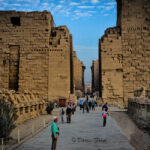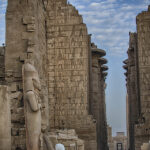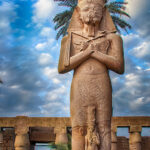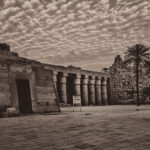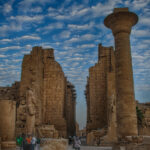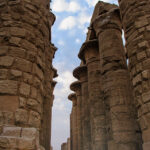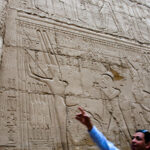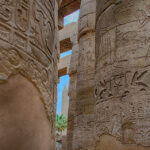Temple of Karnak in Egypt:
Karnak Temple in Egypt is located in Thebes which is now (Modern Luxor), and is actually a temple complex, formerly known as Ipet-isut (Most select of places) by the ancient Egyptians. A city of temples built over 2000 years and dedicated to the Theben triad. The great temple at the heart of Karnak is so big, St Peter’s, Milan and Notre Dame Cathedrals could be lost within its walls. The Hypostyle hall at 54,000 square feet with its 134 columns is still the largest room of any religious building in the world.
“In ancient Egypt, the power of the god Amun of Thebes gradually increased during the early New Kingdom, and after the short persecution led by Akhenaten, it rose to its apex. In the reign of Ramesses III, more than two thirds of the property owned by the temples belonged to Amun, evidenced by the stupendous buildings at Karnak Temple complex. Although badly ruined, no site in Egypt is more impressive than Karnak. It is the largest temple complex ever built by man, and represents the combined achievement of many generations of ancient builders. The Temple of Karnak is actually three main temples, smaller enclosed temples, and several outer temples located about three kilometers north of Luxor, Egypt situated on 100 ha (247 acres) of land. Karnak is actually the sites modern name. Its ancient name was Ipet-isut, meaning “The Most Select (or Sacred) of Places”.
The Temple of Karnak is a “vast complex built and enlarged over a thirteen hundred year period. The three main temples of Mut, Montu and Amun are enclosed by enormous brick walls. The Open Air Museum is located to the north of the first courtyard, across from the Sacred Lake. The main complex, The Temple of Amun, is situated in the center of the entire complex. The Temple of Monthu is to the north of the Temple of Amun, and next to it, on the inside of the enclosure wall is the Temple of Ptah, while the Temple of Mut is to the south. There is also the small Temple dedicated to Khonsu, and next to it, an even smaller Temple of Opet. Actually, there are a number of smaller temples and chapels spread about Karnak, such as the Temple of Osiris Hek-Djet (Heqadjet), which is actually inside the enclosure wall of the Temple of Amun.”
Read more: http://www.touregypt.net/karnak.htm#ixzz2UuEWOe6M
The Karnak Temple in Egypt was a highlight of our visit to Egypt. The carvings on the columns are quite well preserved in places, and some paint can be seen on rare occasions. The tall ornate columns standing in a row dwarf the visitors strolling by as they look up to admire the awesome sites.
In The Temple of Karnak one an easily visualize -“The carving of the one armed man who was the God of Fertility and the Eastern Desert, worshiped since pre-dynastic times. He was later associated with Amun as Amun-Min. He was shown as a human male with one arm and one leg and an erect, large penis. His right arm was raised, holding a flail. The flail is sometimes seen as a symbol of intercourse. The flail forms a V, while the upraised arm was thrust into the V.”
Read on about the scenes in The Temple of Karnak
“This area (Karnak Temple) is very significant because it reveals much of the history of this area through scenes that are displayed in the complex. There are battle scenes between pharaohs and enemies, and rulers were made a permanent part of history through these memorials. Many remarkable displays of the history of this time are still standing, such as the statue of Pinedjem I which is 10.5 meters tall. The sandstone that was used in the temple’s complex was brought from over 100 miles away on the Nile River. Another amazing feature of the Precinct of Amun-Re is the panora of a freize that displays very clear images of ancient characters that still stands today. In 323 AD, when Constantine the Great recognized the Christian religion, the complex was closed down, and Christian churches were built.”
http://www.karnak.org/
